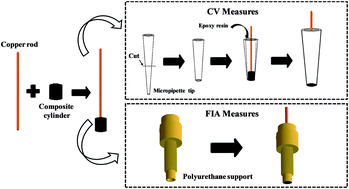A carbon black composite electrode for flow injection amperometric determination of hydrochlorothiazide
Abstract
This work describes a composite electrode based on carbon black (CB) and poly(ethylene-co-vinyl)acetate (EVA) for development of a robust, low cost and time-saving method for the amperometric determination of hydrochlorothiazide (HCTZ) in a pharmaceutical formulation and synthetic human urine samples. This composite electrode exhibits favourable features such as mechanical resistance, low cost and simple preparation. The proposed electrode was used as an amperometric detector in flow injection analysis (FIA) based on HCTZ oxidation. The best amperometric responses were obtained by employing a composite electrode made with 75% (w/w) carbon black (CB) and 25% (w/w) poly(ethylene-co-vinyl)acetate (EVA), sample volume of 100 μL, flow rate of 5.3 mL min−1 and potential of detection of +900 mV vs. Ag/AgCl/3.0 mol L−1. Under optimized conditions, it was possible to achieve an analytical frequency of 128 injections h−1, a linear dynamic range (LDR) of 10 to 200 μmol L−1, a limit of quantification (LOQ) of 4.4 μmol L−1 and a limit of detection (LOD) of 1.3 μmol L−1 for HCTZ. The proposed method was successfully applied for determination of HCTZ in commercial tablets and synthetic human urine samples without any chemical pretreatment. The composite electrode based on EVA and carbon black is feasible and totally adaptable to portable devices for HCTZ quantification.



 Please wait while we load your content...
Please wait while we load your content...